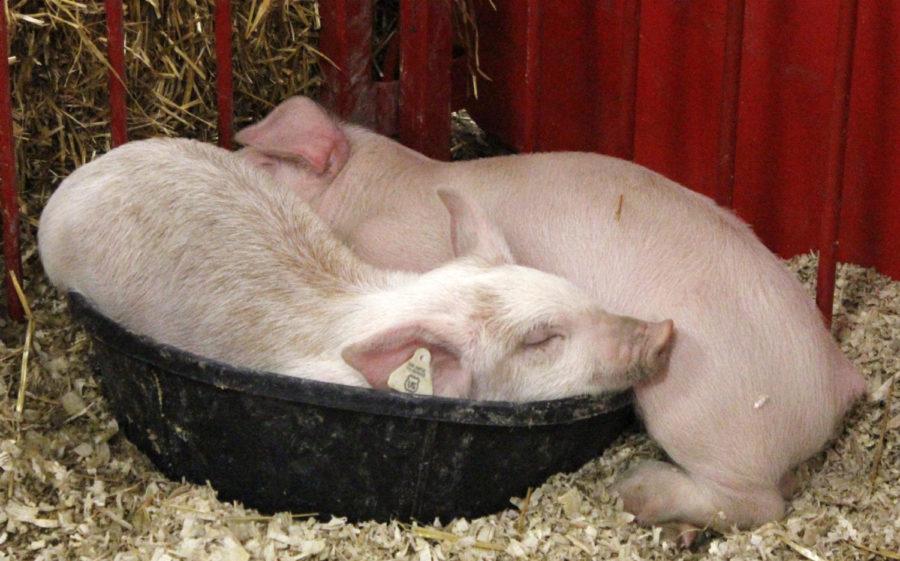Vet med researchers discover virus causing piglet tremors
Caitlin Ellingson/Iowa State Daily
The Iowa State Bacon Expo had live pigs for visitors to see as they learned about the pork industry. The event was held from 1-5 p.m. on Nov. 8 at the Hansen Agricultural Student Learning Center.
February 7, 2016
A strange phenomenon in the swine industry may soon be a moot issue.
Researchers at Iowa State’s College of Veterinary Medicine recently pinpointed a virus in piglets that causes tremors after birth.
The tremors have been noted for decades, but Iowa State was the first to detect the actual virus that causes them.
A team of four diagnostic pathologists began looking into a problem brought to Vet Med by swine farmers. Every so often, a herd of newborn piglets would be born shaking; the shaking would be uncontrollable and constant, other than while sleeping.
This disease is known as congenital tremors and is sometimes referred to as “dancing pigs” or “shaking pigs.” There is not enough data to conclude if this ever goes away in a pig’s life, but consistent studies show that pigs typically adapt over time and it can even be almost completely subsided by the time they are ready for market.
The disease in itself does not cause death, but if the shaking is severe enough, it can cause the piglet to be unable to nurse and die of starvation.
After two years of searching for the virus, the pathologists found a pestivirus.
“We got samples from the farms, and with the collaborators at Boehringer Ingelheim Vetmedica, did next generation sequencing on those samples,” said Bailey Arruda, assistant professor of vet diagnostic and production animal medicine and one of the diagnostic pathologists on the case. “The samples included serum and nervous system tissues.”
The team also used quantitative real-time PCR, or qPCR. The virus was detected by using the qPCR when samples from four farms were tested. Piglets with tremors were found with this virus, while unaffected piglets were not.
Arruda also said the research team did not look for a specific virus, but for the big picture in all of the genetic material. After the team put together the sequences, it learned that the pestivirus causing the tremors was in nearly the whole genome.
The team conducted studies on sows about halfway through their gestation period. There were eight sows used, and five had the virus injected into the uterus, into each individual piglet. The other three had a placebo injected in the uterus into each piglet.
“Anywhere from 57 to 100 percent of piglets, depending on the litter were defined as having congenital tremors,” Arruda said about the piglets injected with the virus.
Kent Schwartz, another diagnostic pathologist on the research, said these results were what they expected.
This disease is not a major problem, but most swine farmers come across this problem at least a couple of times throughout their careers, the diagnostic pathologists said.
“It’s significant for the vaccine, if it was effective, it would be used I think,” Schwartz said. “[Finding the cure] means one less thing that’s going to cause death and suffering in baby pigs.”
The death rate, because of the starvation brought on by this disease, is very small, but the pathologists agreed that the first week of life is the most critical.
There are currently plans for a vaccine to be made based on the information that the diagnostic team discovered. The plans are to have the vaccine injected into the sows before they give birth to prevent any tremors in the piglets.
“This provides a more stable future [for piglets],” said Paulo Arruda, assistant professor of vet diagnostic and production animal medicine and diagnostic pathologist.
The pathologists agreed that there is much more to learn about this virus but know they are headed in the right direction.
“The possibility that this disease could be used to better understand brain physiology or disease in other species I think exists,” Schwartz said.
Future plans for the diagnostic team are to conduct a transmission study to try and learn how the virus can be transmitted. The ultimate goal is to follow this up with a vaccine efficacy trial.
“We want to understand the progression of the disease and the mechanism, why those piglets have tremors,” Arruda said.

















